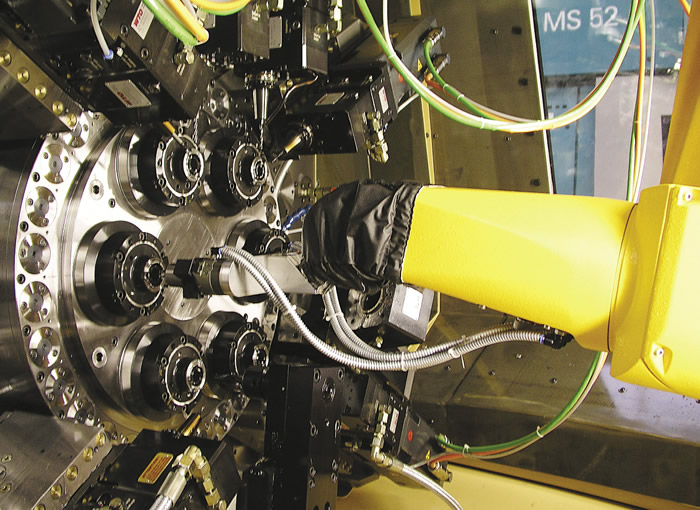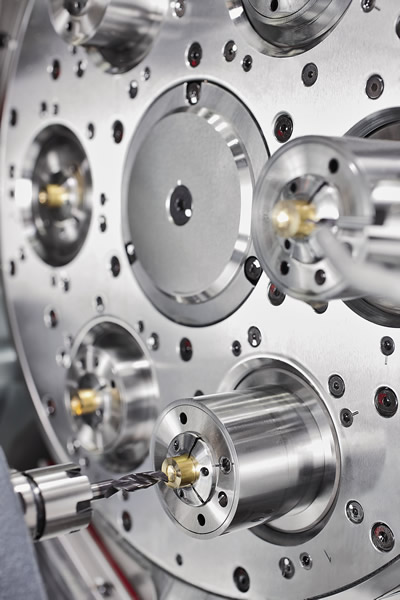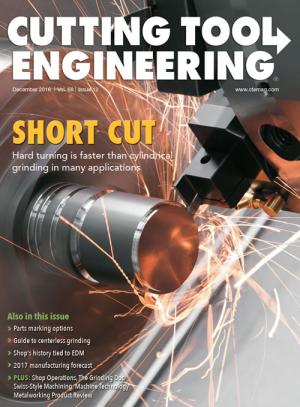Before CNC lathes, most high-volume turned parts were made on multispindle, cam-driven screw machines. Setup times were long, and great skill was needed to design the cams and grind the cutting tools. However, by being able to perform a dozen or more operations simultaneously, they could produce hundreds—often thousands—of parts per hour.
Whatever happened to those old mechanical monsters? According to Giovanni Principe, they’re alive and well.


Robotic part handling increases spindle capacity and reduces floor space requirements. Image courtesy INDEX.

The multispindle national product manager for the Gildemeister line at DMG Mori USA, Hoffman Estates, Ill., Principe said he’s seen renewed interest in multispindles over the past few years, especially CNC models. These machines offer fast setup times and simplified operation, and are far more flexible than their predecessors.
“Tough metals like 4140 and 52100 steel are becoming more common, while part volumes are shrinking, tolerances are getting tighter and workpieces are growing increasingly complex,” Principe said. “All of these things lend themselves well to CNC multispindles.”
Gildemeister still makes cam-driven multispindles, and, according to Principe, demand remains high. But where the rule of thumb for justifying a cam machine is an order of a million parts or more, CNC multispindles are often employed to cost-effectively produce a few hundred or fewer pieces.
“The longest part of setup on any multispindle machine is bar changeover, an activity that might take a few hours,” he said. “If you can avoid this by standardizing on bar size or grouping jobs with like materials, setup time on a CNC machine is often a matter of changing a few tools and calling up a new program. I know a shop in Chicago that routinely does changeovers in 20 minutes or so, and most shops can do them in a couple hours or less.”
All multispindles operate on a share-the-workload principle. Each spindle typically has two (or more) slides: one for end-working operations, such as drilling and boring, and the other for turning, grooving and cutoff. On a 6-spindle machine, for example, the first spindle/slide station might turn and drill, the second station might counterbore and groove and so on until the part is completed. The part cycle time is determined by the longest of the six operations, which is why it’s important to level the machining load across all stations.


Counter-rotating end-working spindles increase operational spindle speeds. Image courtesy Tornos Technologies.

All those moving parts might sound scary, but Principe said programming is actually quite simple. “Anyone who knows CNC can set up one of these machines. It’s a matter of programming each operation individually—face and turn on slide one, drill on slide two, tap on slide three—and the control takes care of the synchronization and makes sure that the longest operation is complete before indexing the spindles. There’s no way to mess it up.”
Philip Miller, managing director for North America at Tornos Technologies Corp., Lombard, Ill., agreed that multispindle setup isn’t the onerous task it once was. “When I started on screw machines, I spent months just learning how to grind tools,” he said. “Today, you’re just buying off-the-shelf inserts and letting the CNC take care of the rest.”
Tornos also makes cam-driven machines, which Miller said are ideally suited for producing “a hundred million or so” fairly simple parts. Unlike their purely mechanical predecessors, however, feed rates on these machines are controlled via a programmable logic controller, providing greater flexibility. For more complex work, there’s full CNC, with AC digital servodrives and a C-axis on each of the machine's spindles.
“Chip control is key on multispindles,” Miller said. “I have a customer in Wisconsin that was stopping its 8-spindle machines every few dozen parts to pull long stringers off the tools. By upgrading to a CNC machine with high-pressure coolant, they’re able to machine 316 stainless around the clock with no problems.”
Many shops have built successful businesses on cam-driven multispindles, Miller noted, but today’s customers are typically those going after specific kinds of parts, such as aerospace components, where challenging materials and complex geometries are the norm. In this arena, only CNC will do.
Parts like these typically benefit from live-tool and Y-axis capabilities as well. Tyler Economan, applications engineering manager at INDEX Corp., Noblesville, Ind., said parts that were once dismissed as multispindle candidates are routinely machined there today. “Some CNC multispindles allow shops to mill flats and slots, drill cross-holes and perform other operations that previously required secondary operations. It’s a real game changer.”
Another game changer is spindle speed. Where old mechanical machines topped out at a few thousand rpm, some of today’s machines boast speeds of 8,000 rpm and higher. And, by using a counter-rotating drill on an end-working station, effective spindle speeds of 15,000 rpm or more are possible.
Anyone who’s stood in the middle of a screw machine shop filled with the sound of hundreds of old-fashioned “rattle tubes” might wonder at the deafening potential of these increased spindle speeds. But Economan pointed out that bar feed technology has kept up with the multispindle world. “We offer bar feeds with automatic bar-loading capabilities,” he said. “These bar loaders use hydrodynamic dampening technology and, in some cases, ID pusher collets. Therefore, it is possible to utilize an ideal spindle liner closer to the actual material size, so noise and bar whip is less of an issue.”
Related Glossary Terms
- boring
boring
Enlarging a hole that already has been drilled or cored. Generally, it is an operation of truing the previously drilled hole with a single-point, lathe-type tool. Boring is essentially internal turning, in that usually a single-point cutting tool forms the internal shape. Some tools are available with two cutting edges to balance cutting forces.
- computer numerical control ( CNC)
computer numerical control ( CNC)
Microprocessor-based controller dedicated to a machine tool that permits the creation or modification of parts. Programmed numerical control activates the machine’s servos and spindle drives and controls the various machining operations. See DNC, direct numerical control; NC, numerical control.
- computer-aided manufacturing ( CAM)
computer-aided manufacturing ( CAM)
Use of computers to control machining and manufacturing processes.
- coolant
coolant
Fluid that reduces temperature buildup at the tool/workpiece interface during machining. Normally takes the form of a liquid such as soluble or chemical mixtures (semisynthetic, synthetic) but can be pressurized air or other gas. Because of water’s ability to absorb great quantities of heat, it is widely used as a coolant and vehicle for various cutting compounds, with the water-to-compound ratio varying with the machining task. See cutting fluid; semisynthetic cutting fluid; soluble-oil cutting fluid; synthetic cutting fluid.
- counterbore
counterbore
Tool, guided by a pilot, that expands a hole to a certain depth.
- cutoff
cutoff
Step that prepares a slug, blank or other workpiece for machining or other processing by separating it from the original stock. Performed on lathes, chucking machines, automatic screw machines and other turning machines. Also performed on milling machines, machining centers with slitting saws and sawing machines with cold (circular) saws, hacksaws, bandsaws or abrasive cutoff saws. See saw, sawing machine; turning.
- feed
feed
Rate of change of position of the tool as a whole, relative to the workpiece while cutting.
- grooving
grooving
Machining grooves and shallow channels. Example: grooving ball-bearing raceways. Typically performed by tools that are capable of light cuts at high feed rates. Imparts high-quality finish.
- inner diameter ( ID)
inner diameter ( ID)
Dimension that defines the inside diameter of a cavity or hole. See OD, outer diameter.
- milling machine ( mill)
milling machine ( mill)
Runs endmills and arbor-mounted milling cutters. Features include a head with a spindle that drives the cutters; a column, knee and table that provide motion in the three Cartesian axes; and a base that supports the components and houses the cutting-fluid pump and reservoir. The work is mounted on the table and fed into the rotating cutter or endmill to accomplish the milling steps; vertical milling machines also feed endmills into the work by means of a spindle-mounted quill. Models range from small manual machines to big bed-type and duplex mills. All take one of three basic forms: vertical, horizontal or convertible horizontal/vertical. Vertical machines may be knee-type (the table is mounted on a knee that can be elevated) or bed-type (the table is securely supported and only moves horizontally). In general, horizontal machines are bigger and more powerful, while vertical machines are lighter but more versatile and easier to set up and operate.
- tap
tap
Cylindrical tool that cuts internal threads and has flutes to remove chips and carry tapping fluid to the point of cut. Normally used on a drill press or tapping machine but also may be operated manually. See tapping.
- turning
turning
Workpiece is held in a chuck, mounted on a face plate or secured between centers and rotated while a cutting tool, normally a single-point tool, is fed into it along its periphery or across its end or face. Takes the form of straight turning (cutting along the periphery of the workpiece); taper turning (creating a taper); step turning (turning different-size diameters on the same work); chamfering (beveling an edge or shoulder); facing (cutting on an end); turning threads (usually external but can be internal); roughing (high-volume metal removal); and finishing (final light cuts). Performed on lathes, turning centers, chucking machines, automatic screw machines and similar machines.


